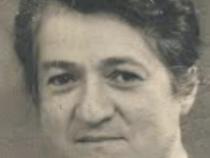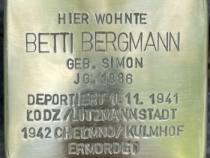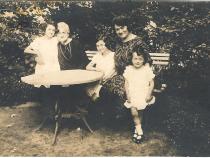Betti Simon was born on 17th February 1886 in Labiau in East Prussia, which is now called Polessk and is in the Russian enclave of Kaliningrad. It is now known how or when Betti got to Berlin. But there she met Hermann Bergmann, a haberdashery salesman who had been born in the same part of the world as her, Kaliningrad in 1878. In May 1912 they got married. They had three children, Edith born in 1916, Ulla in 1917 and Vera in 1921.
Betti was a seamstress, possibly even a fashion designer of a kind, and a housewife. The family knows little for certain about Hermann but many unconfirmed anecdotes have been passed down the generations of his descendants. For a time, he apparently had a job in South Africa as a waiter, but he was fired after he spilt gravy on one diner’s neck. He is said to have oined the German Freikorps and fought alongside the Boers 1899-1902, which suggests he was probably a rather nationalistic German. It is said that he took photographs in South Africa and turned them into postcards - some say that he was a big game hunter. He apparently had at least one book by the renowned sexologist, social reformer and eugenicist Havelock Ellis, which he kept in a locked cupboard, but his daughters knew where the key was. The family seems to have been quite well off and, judging by a photograph of them picnicking in a forest, they owned a large motor car.
Between 1937 and 1938, Betti and Hermann sent their children away from Germany. At the time Jewish refugees fleeing the Nazis could not go to any county they wished and claim asylum, but southern Africa was relatively open and Hermann may well have had connections there. Edith was the first to go in 1937. She went to South Africa. The following year Ulla and Vera left, heading for Southern Rhodesia, perhaps because by that time, it wasn’t easy to get a visa to South Africa. The family memory is that Hermann offered to put Betti on a boat but she refused to leave without her two sisters Gertrud and Ella.
Hermann and Betti were now living in Berlin without their children. On 3rd October 1939, aged 61, Hermann died of heart failure at the Israelite Hospital in Elsasserstr. It was a month after the war broke out, eleven months after Kristallnacht, when Nazis went on a rampage burning down Jewish businesses, synagogues and homes. It is said that Hermann was once attacked in the street by Nazi thugs. It is not hard to imagine Hermann died of a broken heart, his ideal of Germany destroyed, his daughters turned into refugees, yet he may also have felt hope, knowing his daughters were all safe. He is buried in Weissensee cemetery where his grave still stands (Feld O, Abt VII, Reihe $, Grab Nr 101570).
It seems that Betti was moved out of Eyke von Repkow Pl. and to a Judenhaus, a block for Jews, in Agricolastr. 21. She was deported to Lodz on 1st November 1941, two months after Hitler announced the deportation of German Jews. She joined 200,000 other Jews in the horrific conditions of the Jewish ghetto. From a comfortable bourgeois existence in a teaming metropolis, she had been turned into a slave. There was no running water or sanitation in the houses. Bitter cold in winter. No warm clothes. Most people wore wooden clogs for shoes. At any one time a fifth of the population was sick. Betti’s name can be found in the ghetto records, where her profession is described as seamstress, so it is likely she was put to work in one of the ghetto’s many workshops making textiles probably uniforms for the German army.
From January 16th 1942 the Nazis began to send inmates of Lodz ghetto to Chelmno extermination camp, 30 miles away, where between 150 and 340 thousand people were murdered.
Betti was sent to Chelmno on 9th or 10th May 1942, at the age of 56. She would have found herself collected with other prisoners in a manor house there. She would have been ordered to shower, set aside all her clothes except her underwear and then walk in a group with fifty to seventy other Jews via a tunnel into the back of a truck whose sides and top were metal sheets and whose exhaust pipe was looped to feed its fumes into the space where she and others stood. The driver put on a gas mask, turned on the engine and set off. Screams could be heard by those outside. By the time they got to the burial pits at Chelmno, 4km away, everyone in the back of the truck was dead. A Sonderkommando of young Jews were waiting to unload the bodies.
At least three of Betti’s 6 siblings, Getrud, Ella and Benno Simon were also murdered in the Holocaust. Getrud and Ella were deported to Riga on 5th September 1942 and shot on 8th September, while Benno died in Auschwitz.
But Betti’s three children, Edith, Ulla and Vera survived, their lives saved by their parents. They were relatively safe in Rhodesia and South Africa though they were young, vulnerable and far from home.
After the war, the children tried to find their mother. I found a letter in the archives written on 21st August 1946 by Ulla to the tracing service in Berlin “I have obtained your address via the Jewish Community in Berlin and would be very grateful if you could help me in some way or other to find out the location or the fate of my mother and close relatives.”
“I have had heard nothing directly from my mother since the year 1940. I heard from my uncle who was at the time in Holland at the beginning of 1942 through the Red Cross that my mother and her two unmarried sisters were sent to Poland - Address unknown.”
In June 1947 the Red Cross located their file on Betti. They told Ulla that she was sent to Lodz and did not return.






